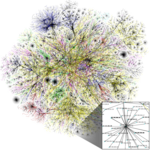| Internet |
|---|
 |
|
|
This article may need to be rewritten to comply with Wikipedia's quality standards. (October 2024) |
Internet culture is a quasi-underground culture developed and maintained among frequent and active users of the Internet (also known as netizens) who primarily communicate with one another as members of online communities; that is, a culture whose influence is "mediated by computer screens" and information communication technology,[1]: 63 specifically the Internet.
Internet culture arises from the frequent interactions between members within various online communities and the use of these communities for communication, entertainment, business, and recreation. The earliest online communities of this kind were centered around the interests and hobbies of anonymous and pseudonymous early adopters, typically those with academic, technological, niche, criminal, or even subversive interests.[citation needed]
Studied aspects of Internet culture include anonymity/pseudonymity, social media, gaming and specific communities, such as fandoms, and has also raised questions about online identity and Internet privacy.[2]
The impact of Internet culture on predominately offline societies and cultures has been extensive, and elements of Internet culture increasingly impact everyday life.[citation needed] Likewise, increasingly widespread Internet adoption has influenced Internet culture; frequently provoking enforcing norms via shaming, censuring and censorship while pressuring other cultural expressions underground.[3]
- ^ Rheingold, Howard (1993). "Daily Life in Cyberspace". The Virtual Community: Homesteading on the Electronic Frontier. HarperCollins. ISBN 0-06-097641-1.
- ^ Silver, David (February 2004). "Internet/Cyberculture/ Digital Culture/New Media/ Fill-in-the-Blank Studies". New Media & Society. 6 (1): 55–64. doi:10.1177/1461444804039915. ISSN 1461-4448. S2CID 32041186. Archived from the original on 2020-09-03. Retrieved 2020-11-27.
- ^ Phillips, Whitney (2019). "It Wasn't Just the Trolls: Early Internet Culture, "Fun," and the Fires of Exclusionary Laughter". Social Media + Society. 5 (3). doi:10.1177/2056305119849493. S2CID 199164695.